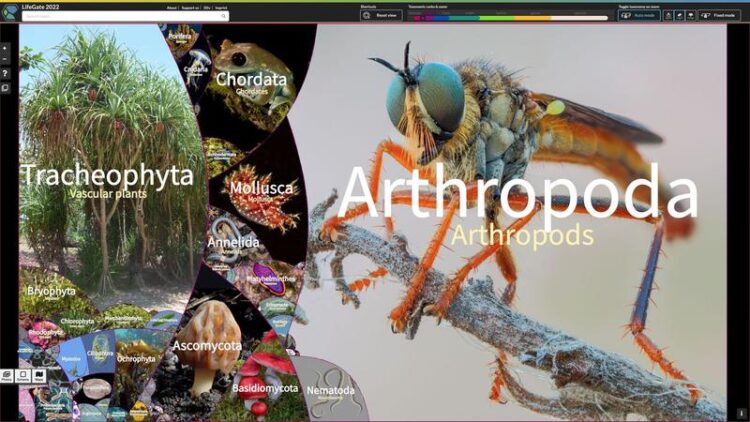LifeGate – New interactive map shows the full diversity of life

LifeGate Home
Bild: Volker Hahn
Researchers from Leipzig published a gigantic digital map displaying the full diversity of life through thousands of photos. The so-called LifeGate encompasses all 2.6 million known species of this planet and shows their relationship to each other. The interactive map can now be accessed free of charge at https://lifegate.idiv.de.
Joint press release of Leipzig University (Botanical Garden) and the German Centre for Integrative Biodiversity Research (iDiv)
If you want to find out which places are close to Quito, you search on Google Maps. If, on the other hand, you want to find out which animals are taxonomically close to the meerkat, you can search on LifeGate. LifeGate is a new interactive map, but it is a taxonomic rather than a geographic map: when you zoom in, you see photos of a species’ closest relative, whether it is the meerkat or any of the other 2.6 million known species. When you zoom out, you see which group (taxon) the species you are looking at belongs to, and which other groups it is related to. The meerkat, for example, belongs to the mongoose family, which is closely related to civets and genets, among other things.
The diversity of life in one map
The online platform LifeGate displays the full diversity of life in a single interactive map. With 420,000 photos already available, the underlying database contains 12 million; from the microscopic paramecium to the giant panda. There are a lot of photos of some species, but none, as yet, of others. 6,000 citizens from all over the world have made their photos available, free of charge, to this non-commercial project, and new images are being added every day.
The creator of LifeGate is Dr Martin Freiberg, curator of the botanical garden at Leipzig University and member of the German Centre for Integrative Biodiversity Research (iDiv). “I wanted to construct LifeGate in such a way that all species are of equal value, and that the incredible diversity of species can really be experienced and understood,” says Freiberg.
A novel representation
During its creation, he based it on the ‘family trees’ of nature: Biologists describe the phylogenetic evolution and relationships of living organisms in so-called phylogenies. Only modern phylogenies already based on DNA analyses have found a place in LifeGate. Such representations are usually limited to individual groups of species and show only birds or frogs, only begonias, orchids or only butterflies, for example. Freiberg has brought the phylogenies together, in painstaking detail for the first time, so that the relationship positions of all species can actually be shown at the same time. “Because LifeGate is not restricted to any one group, this is the first time that relationships between species can be represented,” he says.
Fourteen years of work, finally available to the public
Freiberg has been working on the LifeGate map since 2008 – a feat that also included the technical programming of the platform. Now it will finally be revealed to the public. “LifeGate began as a scientific clarification project for my students,” says Freiberg. “Pictures are more memorable than mere numbers and make the topic of biodiversity more accessible. This is why the map also fascinates amateurs and laypeople. Not only biologists go to the zoo.”
Freiberg still has a lot more planned for the future. For example, you will be able to choose from different photo views for each species. For the meerkat, for example, the eyes or the ears, the head from the front or from the side, the droppings, the footprints and so on. Virtual trips are also planned: Who eats whom? Who pollinates what?
Freiberg’s vision is a ‘Google Maps of Biodiversity’
In order to fulfil his plans, Freiberg and his team now need supporters, especially in the areas of programming and project management, and in continued financing. “It’s just no longer manageable,” he says. The public announcement is intended as a first step towards achieving Freiberg’s vision: “In the future, every online search for animals, plants or bacteria will start with LifeGate. It should become the ‘Google Maps of biodiversity’.”
By the way, Homo sapiens, of course, can also be found in Lifegate. Whoever searches for him finds a photo of Martin Freiberg and his daughter. It’s one of 2.6 million squares on the gigantic map of life – at the top, on the left.
Wissenschaftliche Ansprechpartner:
Dr Martin Freiberg
Curator of the
Botanical Garden at Leipzig University
German Centre for Integrative Biodiversity Research (iDiv) Halle-Jena-Leipzig
Phone: ++49 341 97 36869
Email: freiberg@uni-leipzig.de
Web: https://www.lw.uni-leipzig.de/en/institut-fuer-biologie/abteilungen/systematic-b…
Originalpublikation:
Weitere Informationen:
https://www.idiv.de/youtube-lg1en LifeGate video introduction (2 min)
https://www.idiv.de/youtube-lg2en LifeGate user tutorial (5 min)
Media Contact
All latest news from the category: Life Sciences and Chemistry
Articles and reports from the Life Sciences and chemistry area deal with applied and basic research into modern biology, chemistry and human medicine.
Valuable information can be found on a range of life sciences fields including bacteriology, biochemistry, bionics, bioinformatics, biophysics, biotechnology, genetics, geobotany, human biology, marine biology, microbiology, molecular biology, cellular biology, zoology, bioinorganic chemistry, microchemistry and environmental chemistry.
Newest articles

Can lab-grown neurons exhibit plasticity?
“Neurons that fire together, wire together” describes the neural plasticity seen in human brains, but neurons grown in a dish don’t seem to follow these rules. Neurons that are cultured…

Unlocking the journey of gold through magmatic fluids
By studying sulphur in magmatic fluids at extreme pressures and temperatures, a UNIGE team is revolutionising our understanding of gold transport and ore deposit formation. When one tectonic plate sinks…

3D concrete printing method that captures carbon dioxide
Scientists at Nanyang Technological University, Singapore (NTU Singapore) have developed a 3D concrete printing method that captures carbon, demonstrating a new pathway to reduce the environmental impact of the construction…



